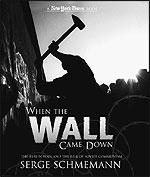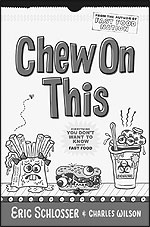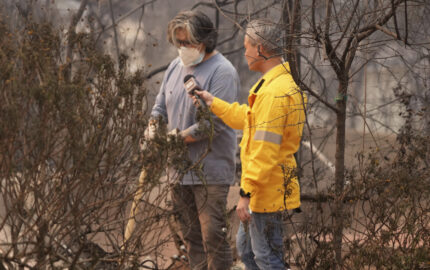For years, newspapers have tried to engage younger readers by meeting them where they are — on the Internet and in the classroom. But despite lively graphics and free handouts, circulation has dipped as young adults glean most of their news from "The Onion" and "The Daily Show." Now The New York Times arrives with a fresh idea that plays to its own strengths: a line of young adult books written by Times reporters on subjects the paper has covered extensively through the years.
The books, aimed at 12 to 18 year-olds, suggest a format that is eminently replicable: choose a subject of interest to a teen audience; tap a reporter with deep experience covering the story to write the core narrative; enhance the story with historic records, abbreviated reports from the Times' archives, and lavish maps and photographs.
The two books, published this spring, are a promising start. In the book, "The North Pole Was Here: Puzzles and Perils at the Top of the World," Times science reporter Andrew Revkin takes readers along as he goes on a scientific expedition to the North Pole to probe the mysteries of global warming. Standing on this beautiful and empty frontier, he describes a landscape in endless motion. His airplane lands on ice that will soon break up and drift away to join the rest of the constantly flowing ice. He shares with readers his anxiety about the ice cracking beneath the weight of his tent, not to mention the airplane, and about wandering away from his group and being discovered by a polar bear. Indeed, many of the scientists keep rifles at their sides. Revkin marvels at a day that lasts six months from sunrise to sunset and a horizon free of vegetation. But most of all he worries about the consequences of climate change and how the warming of the globe might melt arctic ice entirely in the next few generations.
Revkin's account is punctuated with short histories and photographs of early adventurers, many of whom died trying to reach the Pole. Archival articles from the Times let readers revisit the competing claims made by Robert Peary and Frederick Cook as each wanted to be recognized as the first to reach the North Pole in 1909. Articles written nearly a century later report that neither probably succeeded.
There is lots of science embedded in a conversational narrative that draws readers into the expedition's extraordinary challenges in a forbidding environment. Instruments anchored to the deep seabed hold vital information but cannot be retrieved because three bolts on a winch have broken. A year's worth of work is at stake, and the problem must be solved by "a research team that combines the brainpower of scientists with the brute strength of furniture movers," Revkin writes.
In the series' second book, "When the Wall Came Down: The Berlin Wall and the Fall of Soviet Communism," Serge Schmemann, a foreign correspondent with the Times, tells of working in his hotel room in West Berlin one night in 1989 when he learned the wall was coming down. He rushed into the streets to watch and to report. Like Revkin, he weaves his first-person account as a journalist into a narrative that skillfully places the drama of the Berlin Wall into the larger context of the cold war. Schmemann is sensitive to the fact that the world looks much different to youngsters today than it did to us a decade ago and offers young readers a window into a time they've never known.
The Times will publish two more books this fall, "Deadly Invaders: Virus Outbreaks Around the World, From Marburg Fever to Avian Flu" by Science Times reporter Denise Grady and "Speed Show: How NASCAR Won the Heart of America," by Times sports reporter Dave Caldwell. The plan is to publish two books each year for a total of 12. Subjects assigned so far include hurricanes, the history of the computer, and the turbulent year of 1968.
The Times is unabashed about its vision for the series. When these two books were published in the spring, editorial director Alex Ward wrote, "One of the heartening results of this project is the enthusiasm it has engendered in the writers, who see it as an opportunity to revisit an important time in their professional lives and describe it to a whole new audience — one we all hope will be reading the Times for years to come."
Fast Food Kids
In a different effort to reach younger readers, Eric Schlosser, the author of "Fast Food Nation," has joined up with newspaper journalist Charles Wilson to produce "Chew On This: Everything You Don't Want To Know about Fast Food." The book poses similar questions to those asked in "Fast Food Nation" (Do you really know where that fast food comes from? If so, do you still want to eat it?), but adds a wealth of new reporting about the pervasiveness of fast food in the nation's schools, the explosion in obesity among children, and the determination of advertisers and fast food chains to hook children when they're young and set their brand loyalty early.
Young people are not only the book's target audience but also its main characters, and much of this distressing story is told through their experiences. Seventeen-year old Danielle Brent needs to keep her low-paying job at McDonald's but often works until two in the morning, leaving her too tired to do her homework and sleepy at her desk the next day. Jade Alexander, 13, eats potato chips for breakfast and buys her lunch at the school store next to the cafeteria. "They have this thing called ketchup chips — potato chips with ketchup flavor on them," she reports. "The store also has Bee honey-barbecue chips, and they have Combos, Fruit Roll-Ups, candy and cookies." After school, Jade meets friends at the nearby McDonald's, KFC or Wendy's.
Sam Fabrikant devoured fast food for many years. Dozens of fast food restaurants cluster near his school and up and down the highway. It was easy for Sam and his friends to rush out of school at lunchtime each day for a meal of Big Macs, Whoppers and fries. By the time Sam was 15 years old, he weighed 290 pounds. The authors pick up Sam's story as he makes the decision to undergo gastric bypass surgery — a drastic and sometimes dangerous operation that is increasingly common among teenagers. Sam, who is 16 when he undergoes the surgery, is comforted by the example of his twin brother, Charlie, who had the surgery a year earlier when he weighed 350 pounds. The brothers are alarming examples of the effects of fast food, loaded with fat and salt, on childhood obesity. As the authors remind their young readers, heart attacks among teenagers are on the rise as well as asthma, heart disease, and diabetes.
"Chew On This" makes a nod to personal responsibility for what one eats but also blames advertising, children's television, as well as the prevalence of soda and junk food in schools. The book also includes stories of healthy eating. It profiles chef Alice Waters, who launched her famous restaurant in Berkeley and persuaded several local middle schools to adopt healthy menus and involve kids in planting and preparing the food they eat. It also lets its young readers know about the In-N-Out Burger chain and Burgerville, which pay good wages and benefits, cook fresh food, use local farmers, and are still highly profitable.
The New York Times books for young adults and "Chew On This" share a common approach: They use a core of existing material, rework it with young adults in mind, and then add reporting and illustrations to make a comprehensive story. While the Times books are told in the first-person voice and "Chew On This" is not, vivid portraits make these stories much more engaging than most serious nonfiction for young readers, which tends to the tedious.
The content of these books is simplified but not condescending. That said, none of them is for the teenager who is less than a fluent reader. Indeed, all of them could easily interest an adult audience and probably will. But how successful will the Times books be in bringing young readers to the newspaper itself? First, they may help develop in teens a taste for serious, nonfiction writing. Second, the books will certainly expose teens to the style and sweep of the Times and, at a minimum, demystify the paper to a generation that probably has never read The New York Times. That may not be enough to make them steady subscribers, but it will be a good start.
Judy Stoia, a 1980 Nieman Fellow, is executive producer of "Between the Lions," an award-winning PBS television series that helps young children learn to read.
The books, aimed at 12 to 18 year-olds, suggest a format that is eminently replicable: choose a subject of interest to a teen audience; tap a reporter with deep experience covering the story to write the core narrative; enhance the story with historic records, abbreviated reports from the Times' archives, and lavish maps and photographs.
The two books, published this spring, are a promising start. In the book, "The North Pole Was Here: Puzzles and Perils at the Top of the World," Times science reporter Andrew Revkin takes readers along as he goes on a scientific expedition to the North Pole to probe the mysteries of global warming. Standing on this beautiful and empty frontier, he describes a landscape in endless motion. His airplane lands on ice that will soon break up and drift away to join the rest of the constantly flowing ice. He shares with readers his anxiety about the ice cracking beneath the weight of his tent, not to mention the airplane, and about wandering away from his group and being discovered by a polar bear. Indeed, many of the scientists keep rifles at their sides. Revkin marvels at a day that lasts six months from sunrise to sunset and a horizon free of vegetation. But most of all he worries about the consequences of climate change and how the warming of the globe might melt arctic ice entirely in the next few generations.
Revkin's account is punctuated with short histories and photographs of early adventurers, many of whom died trying to reach the Pole. Archival articles from the Times let readers revisit the competing claims made by Robert Peary and Frederick Cook as each wanted to be recognized as the first to reach the North Pole in 1909. Articles written nearly a century later report that neither probably succeeded.
There is lots of science embedded in a conversational narrative that draws readers into the expedition's extraordinary challenges in a forbidding environment. Instruments anchored to the deep seabed hold vital information but cannot be retrieved because three bolts on a winch have broken. A year's worth of work is at stake, and the problem must be solved by "a research team that combines the brainpower of scientists with the brute strength of furniture movers," Revkin writes.
In the series' second book, "When the Wall Came Down: The Berlin Wall and the Fall of Soviet Communism," Serge Schmemann, a foreign correspondent with the Times, tells of working in his hotel room in West Berlin one night in 1989 when he learned the wall was coming down. He rushed into the streets to watch and to report. Like Revkin, he weaves his first-person account as a journalist into a narrative that skillfully places the drama of the Berlin Wall into the larger context of the cold war. Schmemann is sensitive to the fact that the world looks much different to youngsters today than it did to us a decade ago and offers young readers a window into a time they've never known.
The Times will publish two more books this fall, "Deadly Invaders: Virus Outbreaks Around the World, From Marburg Fever to Avian Flu" by Science Times reporter Denise Grady and "Speed Show: How NASCAR Won the Heart of America," by Times sports reporter Dave Caldwell. The plan is to publish two books each year for a total of 12. Subjects assigned so far include hurricanes, the history of the computer, and the turbulent year of 1968.
The Times is unabashed about its vision for the series. When these two books were published in the spring, editorial director Alex Ward wrote, "One of the heartening results of this project is the enthusiasm it has engendered in the writers, who see it as an opportunity to revisit an important time in their professional lives and describe it to a whole new audience — one we all hope will be reading the Times for years to come."
Fast Food Kids
In a different effort to reach younger readers, Eric Schlosser, the author of "Fast Food Nation," has joined up with newspaper journalist Charles Wilson to produce "Chew On This: Everything You Don't Want To Know about Fast Food." The book poses similar questions to those asked in "Fast Food Nation" (Do you really know where that fast food comes from? If so, do you still want to eat it?), but adds a wealth of new reporting about the pervasiveness of fast food in the nation's schools, the explosion in obesity among children, and the determination of advertisers and fast food chains to hook children when they're young and set their brand loyalty early.
Young people are not only the book's target audience but also its main characters, and much of this distressing story is told through their experiences. Seventeen-year old Danielle Brent needs to keep her low-paying job at McDonald's but often works until two in the morning, leaving her too tired to do her homework and sleepy at her desk the next day. Jade Alexander, 13, eats potato chips for breakfast and buys her lunch at the school store next to the cafeteria. "They have this thing called ketchup chips — potato chips with ketchup flavor on them," she reports. "The store also has Bee honey-barbecue chips, and they have Combos, Fruit Roll-Ups, candy and cookies." After school, Jade meets friends at the nearby McDonald's, KFC or Wendy's.
Sam Fabrikant devoured fast food for many years. Dozens of fast food restaurants cluster near his school and up and down the highway. It was easy for Sam and his friends to rush out of school at lunchtime each day for a meal of Big Macs, Whoppers and fries. By the time Sam was 15 years old, he weighed 290 pounds. The authors pick up Sam's story as he makes the decision to undergo gastric bypass surgery — a drastic and sometimes dangerous operation that is increasingly common among teenagers. Sam, who is 16 when he undergoes the surgery, is comforted by the example of his twin brother, Charlie, who had the surgery a year earlier when he weighed 350 pounds. The brothers are alarming examples of the effects of fast food, loaded with fat and salt, on childhood obesity. As the authors remind their young readers, heart attacks among teenagers are on the rise as well as asthma, heart disease, and diabetes.
"Chew On This" makes a nod to personal responsibility for what one eats but also blames advertising, children's television, as well as the prevalence of soda and junk food in schools. The book also includes stories of healthy eating. It profiles chef Alice Waters, who launched her famous restaurant in Berkeley and persuaded several local middle schools to adopt healthy menus and involve kids in planting and preparing the food they eat. It also lets its young readers know about the In-N-Out Burger chain and Burgerville, which pay good wages and benefits, cook fresh food, use local farmers, and are still highly profitable.
The New York Times books for young adults and "Chew On This" share a common approach: They use a core of existing material, rework it with young adults in mind, and then add reporting and illustrations to make a comprehensive story. While the Times books are told in the first-person voice and "Chew On This" is not, vivid portraits make these stories much more engaging than most serious nonfiction for young readers, which tends to the tedious.
The content of these books is simplified but not condescending. That said, none of them is for the teenager who is less than a fluent reader. Indeed, all of them could easily interest an adult audience and probably will. But how successful will the Times books be in bringing young readers to the newspaper itself? First, they may help develop in teens a taste for serious, nonfiction writing. Second, the books will certainly expose teens to the style and sweep of the Times and, at a minimum, demystify the paper to a generation that probably has never read The New York Times. That may not be enough to make them steady subscribers, but it will be a good start.
Judy Stoia, a 1980 Nieman Fellow, is executive producer of "Between the Lions," an award-winning PBS television series that helps young children learn to read.






